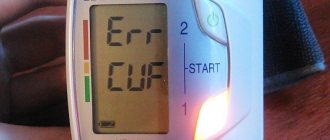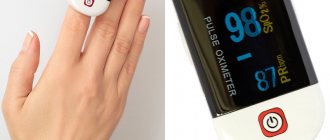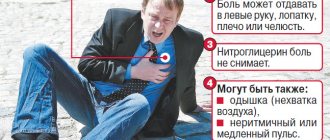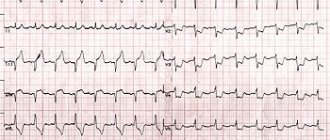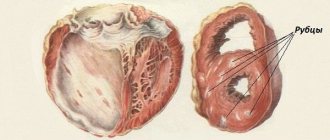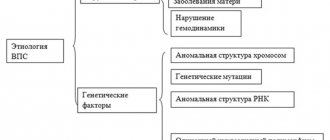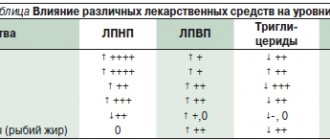Updated: 08/31/2021 13:10:30
Expert: Elizaveta Rubinstein
*Review of the best according to the editors of expertology.ru. About the selection criteria. This material is subjective in nature, does not constitute advertising and does not serve as a purchase guide. Before purchasing, consultation with a specialist is required.
People facing such problems as hypertension and hypotension must have a blood pressure monitor. The most compact models are those that are worn on the wrist. The main parameter when choosing a wrist tonometer is usually its price category. However, there are many other features to consider before purchasing.
Read in this article:
- Benefits of wrist tonometers
- Who is a wrist blood pressure monitor suitable for?
- When is the best time to choose a shoulder tonometer?
- How to measure blood pressure with a wrist tonometer?
- How to choose a wrist blood pressure monitor?
- A simple and convenient way to measure pressure
The easiest way to measure blood pressure yourself is with an automatic tonometer. This device does almost everything itself: just press the power button, and it will determine the upper and lower pressure, and at the same time the pulse rate. Moreover, modern devices can measure these indicators even on the go, for example, while walking. This function is performed by wrist tonometers.
Benefits of wrist tonometers
As the name suggests, the device needs to be fixed on the wrist in much the same way as a watch. Unlike shoulder tonometers, the cuff and electronic unit together with the screen are combined here into a monolithic structure. Wrist blood pressure monitors are popular because they have several important advantages:
- Compactness and light weight - the device is convenient to take with you anywhere, it does not create a feeling of heaviness or discomfort at all;
- Universal cuff size - the device is suitable for any hand;
- Lack of connecting pipes and other external elements;
- High accuracy - this type of tonometer gives no less accurate readings than the usual shoulder device;
- Ease of use – device control is intuitive, indicators are displayed in a convenient form;
- Speed – the measurement takes only a few minutes.
Reducing the volume of the cuff and compressor has reduced energy consumption. An automatic wrist blood pressure monitor does not require a large power supply; small batteries or a rechargeable battery are sufficient. In both cases, the charge is enough for a large number of measurements. The advantages include a stylish design, a large selection of models and the ability to measure blood pressure in any conditions without outside help.
Surgery
Styloiditis is treated surgically in the following cases:
- failure of conservative therapy, including glucocorticoid injections, for 1 month;
- blockade of the finger in the flexion position.
The essence of the operation: opening the canal in which the tendon moves and its decompression (removing pressure) for normal gliding. This is a non-traumatic operation that is performed on an outpatient basis under local anesthesia.
The operation is performed on an arm that has been drained of blood using a cuff. Doctors use optics to see arm tissue under magnification and avoid damage to nerves and blood vessels. When surgically treating styloiditis, it is especially important not to damage the sensitive branches of the radial nerve, which are hidden in adipose tissue.
Surgical treatment is highly effective: up to 96% of patients obtain good or excellent results. The risk of complications does not exceed 2%. The main ones are injury to the radial nerve and the formation of keloid scars. In the long term, relapses are observed in only 5% of patients.
In recent years, endoscopic operations have been increasingly performed. They are less traumatic, safer, and reduce the risk of complications. A better aesthetic effect is ensured, since the incision on the skin is smaller. Patients recover faster after such operations.
Who is a wrist blood pressure monitor suitable for?
At first glance, wrist blood pressure monitors are suitable for absolutely everyone. However, in reality this is not entirely true; there are some nuances. Devices of this type are really good for:
- Overweight people or athletes whose biceps circumference is quite large - not only a standard, but also a large cuff may not fit them, and the measurement process itself sometimes causes discomfort;
- People with pathologies of the joints and shoulder bones - this creates problems when using tonometers with a shoulder cuff;
- Those who are unable to measure shoulder pressure due to skin conditions such as eczema;
- People with very fragile vessels or thrombocytosis - in them, compression of the shoulder with a cuff during measurement provokes hemorrhages, which are clearly visible on the skin;
- Children over 12 years old - standard cuffs may be too big for them.
This tonometer is indispensable for those who have a tendency to hypertension and pressure surges. Adequate physical activity, such as walking, is recommended for such people. To calculate such a load, determine the appropriate pace and distance, you need to control the body’s reaction, i.e. pulse and blood pressure. In this case, a wrist tonometer will be very useful.
This model would also be a good idea for travelers. The small and lightweight device is much more convenient to take with you on trips and business trips than a shoulder tonometer.
Symptoms
The diagnosis in most cases can be established by clinical methods, since the disease has characteristic symptoms.
Patients complain about:
- wrist pain;
- limited mobility;
- decreased muscle strength;
- Difficulty abducting the hand.
Pain may be absent at rest, and at an early stage of the disease appears only with physical activity. Based on which specific movements cause pain, the doctor can understand which tendon is inflamed. Typically, these are the tendons of the abductor pollicis longus muscle or the extensor pollicis brevis muscle.
If patients endure pain for a long time, it intensifies. Over time, the pain syndrome begins to torment a person even at rest; many wake up at night from unbearable pain. Some patients hear or feel the tendon creak when moving the hand.
To confirm the diagnosis, instrumental methods can be used: ultrasound or MRI.
When is the best time to choose a shoulder tonometer?
But a wrist tonometer for older people is not the best idea, despite all the convenience of this device. The fact is that with age, the elasticity of blood vessels begins to decrease. This happens from about 40 years of age, and from this age it is recommended to use shoulder blood pressure monitors. The vessels on the shoulder are larger, so heartbeats and blood flow can be heard better, which means the readings will be more accurate.
There is another reason why wrist blood pressure monitors are not recommended for older people. This is atherosclerosis of the arteries, which can also significantly affect the accuracy of the results. In addition, an elderly person may have hand tremors, so the measurement results may be unreliable. Such tonometers are not suitable for people with pathologies in the form of a protruding bone on the wrist or microtrauma in this area.
Principles of treatment
There is no single treatment strategy that would suit all patients. Typically, doctors start with less invasive and safer interventions, and if they are insufficiently effective, they move on to more aggressive treatment tactics.
Algorithm of action of an orthopedic doctor:
1. Conservative therapy.
2. Glucocorticoid injections – if other conservative methods are ineffective.
3. Surgical treatment if conservative therapy does not work.
How to measure blood pressure with a wrist tonometer?
To obtain accurate data, you need to know how to correctly measure pressure with a wrist tonometer and follow the basic rules:
- To measure, you need to unbutton the sleeve, move the clothes so that there is room for the cuff;
- It is necessary to ensure that the rolled up sleeve does not squeeze the arm or squeeze the blood vessels;
- All jewelry from the wrist must be removed;
- The hand should be positioned so that the thumb points upward;
- The cuff must be wrapped tightly around the arm, leaving the screen on top;
- The edge of the cuff should be 1-2 cm from the hand;
- The hand on which the blood pressure is measured should be placed on the opposite forearm so that the electronic unit is at the level of the heart.
Then all that remains is to turn on the device, wait until it takes a measurement, and study the data on the display. You cannot move or talk while the tonometer is working. For those who use a wrist tonometer for the first time, doctors recommend measuring the pressure on both hands, remembering which hand the reading was higher on, and then taking measurements on that hand in the future. If necessary, the procedure can be repeated, but not earlier than after 5 minutes, so that the vessels have time to recover after compression.
Local injection therapy
The conservative treatment measures listed above only work at an early stage. But most patients present with severe pain, so in 80% of cases glucocorticoid injections are used for treatment. They help quickly relieve inflammation and reduce pain. The therapy is effective in more than 90% of patients. In 58% of patients, the results last more than 1 year after 1 injection, in 73% - after 2 injections.
Indications for local administration of glucocorticoids:
- strong pain;
- ineffectiveness of initial therapy;
- disease duration up to 4 months.
Injections of corticosteroids are also possible if the pathology is up to 12 months old, but the effect is less pronounced, since by this time profound changes in the ligament occur.
Complications of treatment:
- temporary stiffness of the first finger – develops in every third patient;
- increased pain on the first day - in one case out of three;
- skin pigmentation or depigmentation - in case of superficial injection;
- impaired skin sensitivity - in case of injection of drugs into the area of the radial nerve;
- bleeding with the formation of a hematoma.
Glucocorticoids are administered along with a local anesthetic. It acts instantly, turning off the sensitivity of nerve endings. But after a few hours, the effect of the drug wears off and the pain may return. The final result from the administration of glucocorticoids is achieved only after a few days, but significant improvement is noted already on the second day.
After administration of the drug, immobilization is required for 1 to 3 days and limitation of physical labor for up to 7 days. If there is no sufficient effect from the injection, the procedure can be repeated after 2-3 weeks. However, frequent use of corticosteroids is undesirable, as it leads to soft tissue atrophy. Therefore, if there is no sufficient effect, doctors proceed to surgical treatment.
How to choose a wrist blood pressure monitor?
Those for whom such a device suits all parameters will have to decide which wrist tonometer is better. When choosing a suitable model, you should pay attention to the suitability of the cuff to the size of your hand, as well as the size of the numbers on the screen, especially if the device will be used by a person with poor vision.
An important nuance is additional functions that can be very useful. For example, all Beurer brand wrist blood pressure monitors detect arrhythmia (heart rhythm failure) and compare pressure readings with WHO standards, displaying the degree of danger of arterial hypertension on a special scale.
Each model has its own characteristics:
- Beurer BC 32 is the most affordable option in the manufacturer’s line. The results are stored in memory, 60 cells are available for 2 users;
- Beurer BC 28 is a simple and convenient device that stores and averages all indicators or values obtained in the morning and evening;
- Beurer BC 40 – model with Inflation technology function for quick measurements directly while inflating the cuff;
- Beurer BC 44 – a tonometer with a blue backlit screen and large numbers, suitable for people with impaired vision;
- Beurer BC 57 - a device with the ability to transfer data to a computer or smartphone via the HealthManager application for assessing dynamics;
- Beurer BC 50 is a lightweight and compact model with a thin body and a large display;
- Beurer BC 58 - an option for lovers of modern technology with touch controls, synchronization with a mobile application and a USB cable included;
- Beurer BC 85 is a tonometer capable of transmitting data via Bluetooth and monitoring the correct position of the cuff relative to the heart.
All of the listed wrist tonometers have undergone clinical trials and were included in the Register of Medical Equipment and Medical Products in Belarus. This is a confirmation of the high quality of the instruments, as well as their accuracy.
Omron R1
Omron R1 is suitable for self-monitoring of blood pressure and heart rate on the road, at work and at home. The digital display shows all readings in a short period of time. The built-in intelligent system automatically regulates the degree of inflation of the cuff.
Peculiarities:
- Compact size and storage case;
- Automatic inflation of the cuff;
- 5 years warranty for the device;
- Adjustable cuff.
Advantages:
Saving the latest measurements. A convenient device for active users and athletes. You can monitor your blood pressure uninterruptedly at any time.
Flaws:
There is no arrhythmia indicator or voice guidance.
Overall rating:
Omron R1 is an ideal option for home use at a low price. All the necessary functions, as well as a plastic case for transportation, make the device mobile and useful on the road, in the gym, in the hospital, and in the country.
